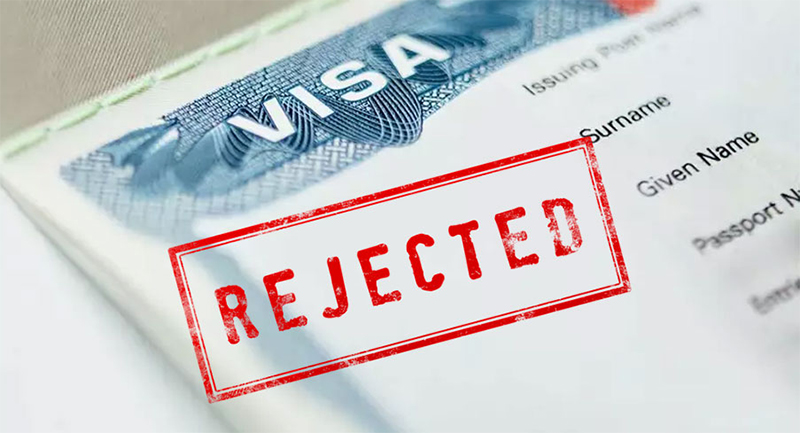
Canada Tightens Immigration Policies: Record Visa Rejections for Study, Work, and Visitor Permits
Canada, once seen as an open and welcoming country for international students, workers, and visitors, is taking a more restrictive approach to immigration. In 2024, the country experienced a dramatic increase in the rejection of temporary resident visa applications, a trend that has reshaped the Canadian immigration landscape. With stricter visa regulations, Canada rejected a record 2.36 million applications—accounting for 50% of all submissions. This marks a significant rise from the previous year, where 35% of applications were denied. The surge in refusals includes visitor visas, study permits, and work permits, all of which are now under heightened scrutiny.
A Record-Breaking Wave of Rejections
In 2024, Immigration, Refugees and Citizenship Canada (IRCC) rejected 2.36 million temporary resident applications, the highest number in recent history. This figure represents a 15% increase from 2023 when 1.85 million applications, or 35%, were turned down.
The breakdown of these refusals reveals some key trends across different visa categories:
| Visa Type | Total Applications Denied | Refusal Rate (2024) | Change from 2023 |
|---|---|---|---|
| Visitor Visas | 1.95 million | 54% | +14% |
| Study Permits | 290,317 | 52% | +14% |
| Work Permits | 115,549 | 22% | -1% |
This unprecedented rejection wave reflects a shift in immigration policy aimed at addressing a variety of internal and external pressures.
Why Are Refusals on the Rise?
Several key factors have contributed to this significant increase in visa rejections, reflecting Canada’s evolving immigration strategy.
1. Population Control and Resource Strain
Canada has experienced a sharp increase in its population, largely due to the influx of temporary residents post-pandemic. As of 2023, 6.5% of Canada’s population consisted of temporary residents. This rapid growth has led to significant strains on the country’s housing, healthcare, and public services.
To address these challenges, Canada’s government introduced a plan to reduce the proportion of temporary residents to 5% of the population by 2026. This policy shift directly impacted visa refusals in 2024, particularly for visitor visas, which now face more stringent scrutiny.
2. Overhaul of the International Student Program
International students have been one of the hardest-hit groups, as the Canadian government aims to stabilize the rapidly expanding education sector. In 2024, the government imposed a cap on new study permits at 360,000—a significant move after years of uncontrolled growth. Along with this cap, stricter eligibility criteria were introduced, including:
- Designated Learning Institutions (DLIs): Only schools with recognized support systems for international students are prioritized, excluding many lesser-known institutions.
- Fraud Prevention: A new Letter of Acceptance (LOA) verification process exposed nearly 9,000 fraudulent applications, which led to a surge in rejections.
- Financial Requirements: Higher proof of financial stability, aligned with Statistics Canada’s low-income cut-off (LICO), caused many students to fail the financial criteria, leading to more refusals.
These changes pushed the study permit rejection rate from 38% in 2023 to 52% in 2024, disrupting the plans of thousands of international students hoping to study in Canada.
3. Increased Visitor Visa Scrutiny
Visitor visa refusals also saw a significant increase, reaching 54% in 2024—up from 40% in 2023. Canada has become more cautious about visitor visa applications to avoid the potential for overstays. The most common reasons for rejection include:
- Insufficient ties to home country, such as lack of family, job, or property to return to
- Unclear travel purpose, with applicants failing to demonstrate valid reasons for visiting
This surge in refusals marks a stark reversal from Canada’s historically welcoming stance toward tourists and visitors.
4. Work Permit Refusals: A Mixed Outcome
The refusal rate for work permits declined slightly in 2024, from 23% to 22%. This decrease suggests that Canada’s approach to work permits is more nuanced. The government has introduced stricter Labour Market Impact Assessments (LMIAs) for low-skill workers while prioritizing workers who can fill gaps in key sectors such as healthcare and construction. These targeted measures aim to balance Canada’s need for foreign workers with immigration control.
Economic Implications of the Visa Crackdown
The surge in visa refusals brings both positive and negative economic consequences for Canada.
Positive Impact: Easing Strain on Infrastructure
One of the key benefits of reducing the number of temporary residents is the alleviation of pressure on Canada’s overburdened infrastructure. As rental vacancies plummeted to a historic low of 1.5% in 2023, fewer newcomers could help stabilize housing demand. Similarly, the strain on healthcare services, which had been exacerbated by population growth, may ease somewhat.
However, these gains may be short-lived due to ongoing construction lags and an aging population.
Negative Impact: Talent and Tourism at Risk
On the downside, Canada’s reputation as a global talent hub is in jeopardy. International students contribute over CAD $22 billion annually to the economy, and universities depend heavily on foreign tuition. The rise in study permit refusals threatens this crucial revenue stream.
Additionally, businesses may struggle to fill roles in essential sectors if work permit approvals stagnate, hindering Canada’s economic growth. Tourism, a CAD $102 billion industry pre-pandemic, is also at risk. The increase in visitor visa refusals could undermine Canada’s recovery as a leading global travel destination.
“We’re sending a signal that Canada is closed for business,” warned an immigration consultant.
The Road Ahead: What Does This Mean for Applicants?
Canada’s immigration trajectory remains uncertain. Despite the tightening of visa regulations, economic realities, such as labour shortages and an aging population, may eventually force the government to reassess its stance.
For prospective applicants, the road ahead is now more challenging. Experts recommend strengthening applications by providing:
- Proof of funds to demonstrate financial stability
- Strong ties to the home country to assure officials of applicants’ intent to return
- Clear travel intent or educational goals to avoid ambiguity
The Canadian government’s future immigration policies will continue to evolve, and for now, the path to a study permit, work permit, or visitor visa will require more detailed and thorough documentation to succeed.
Conclusion
Canada’s decision to reject a record number of temporary resident applications has undoubtedly reshaped its immigration policies. While this may ease certain internal pressures, it poses a significant challenge for those hoping to come to Canada for education, work, or tourism. Moving forward, applicants will need to adapt to stricter criteria and prepare their applications more meticulously to stand a better chance of approval.
For a consultation about Immigration options, reach out to the CAD IMMIGRATION today!





